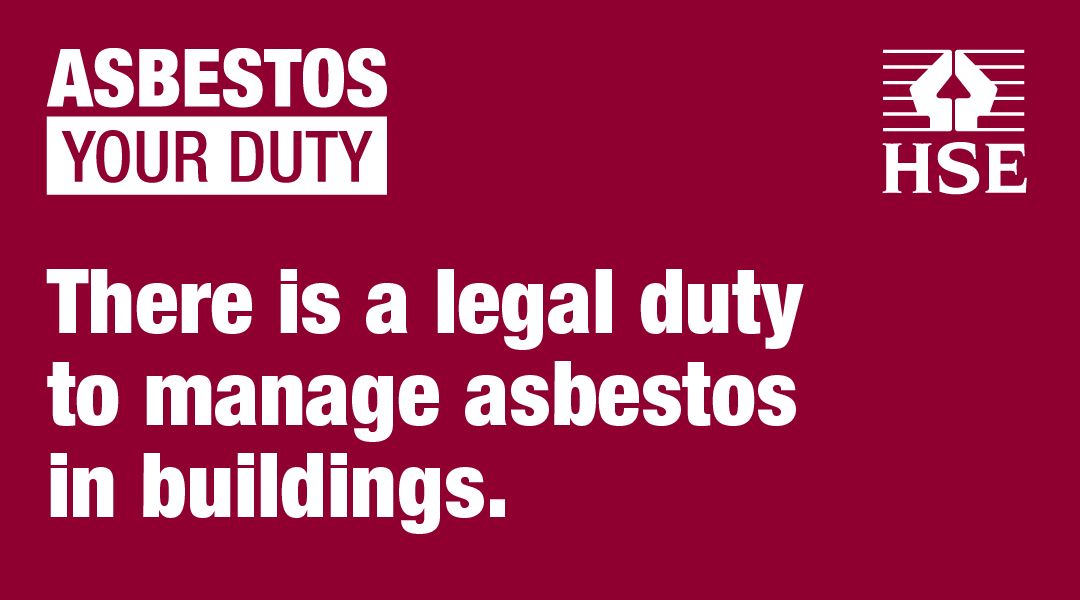What The HSE’s Latest Campaign ‘Asbestos: Your Duty’ Means for You
Those responsible for buildings must carry out necessary checks and fully comprehend their legal obligations

Asbestos, a dangerous material widely used in construction before its ban in 1999, continues to pose a threat in buildings built before 2000. To address this issue and protect people from the harmful effects of asbestos, the Health and Safety Executive (HSE) has launched a new campaign called "Asbestos: Your Duty." Launched on January 15th 2024, this campaign aims to raise awareness of the legal duty to manage asbestos and emphasizes the need for effective management to prevent exposure in workplaces, schools, hospitals, and other buildings that people use in their daily lives.
Understanding the Legal Duty to Manage Asbestos
The legal duty to manage asbestos encompasses a wide range of buildings, including museums, schools, hospitals, places of worship, offices, and factories. The regulations also cover work undertaken within domestic premises by tradespeople, who must be able to demonstrate that a suitable assessment has been undertaken to identify any asbestos containing materials prior to any intrusive work being undertaken. It is especially crucial for premises constructed between 1950 and 1980, when asbestos use was at its peak. Under regulation 4 of the Control of Asbestos Regulations 2012, those responsible for these buildings must carry out necessary checks and fully comprehend their legal obligations.
When asbestos is properly contained, visitors and workers in these buildings are not exposed to its dangers. However, when disturbed or damaged, asbestos can become hazardous. Therefore, it is essential for businesses and organisations to ensure they have robust arrangements in place to manage asbestos risks effectively.
HSE's Campaign: Asbestos: Your Duty
The HSE's campaign, Asbestos: Your Duty, seeks to promote a culture of safely managing asbestos in the building industry and among those responsible for buildings. It aims to reduce work-related ill health caused by asbestos exposure, which remains the leading cause of work-related deaths in Great Britain, despite the prohibition being in place for nearly quarter of a century.
As part of the campaign, the HSE provides updated information and explanatory videos on its website. These resources serve to assist anyone unsure of their legal duties or in need of refreshing their knowledge on managing asbestos.
The Importance of Compliance and Enforcement
To ensure compliance with the Control of Asbestos Regulations 2012, the HSE conducts routine inspections in various buildings, such as schools, factories, and hospitals. During these inspections, the HSE assesses policies, procedures and actual practices on site. With the new campaign, a clear focus on how asbestos is managed will be at the forefront of these visits and enforcement officers will expect those responsible for managing asbestos within buildings to have appropriate arrangements in place.
Non-compliance can result in enforcement actions, including fee for intervention, improvement notices, prohibition notices, and in severe cases, prosecution. Therefore, it is crucial for organisations to prioritise compliance and take proactive measures to manage the risks posed by asbestos-containing materials.
Consulo Compliance: Your Partner in Asbestos Management
Managing asbestos risks and maintaining compliance with the Control of Asbestos Regulations 2012 may seem daunting, but it doesn't have to be. Consulo Compliance is here to help. We specialise in assisting clients in developing bespoke, robust asbestos management plans and ensuring ongoing compliance with the regulations.
Our team of experts can guide you through the process, ensuring that your key personnel receive suitable training in asbestos awareness. We will work with you to create a comprehensive asbestos management plan and ensure your asbestos register is up to date. Additionally, we can help you effectively manage contractors working on your site, minimising the risk of exposure for your employees.
The Cost of Non-Compliance and the Benefits of Compliance
Becoming compliant with asbestos management regulations is not as costly as you might think. Moreover, once you achieve compliance, maintaining it becomes relatively easy. With our assistance, you could be fully compliant in as little as 10 days.
Non-compliance, on the other hand, can lead to serious consequences, both in terms of financial penalties and, more importantly, the health and safety of your employees. The HSE's increased focus on managing asbestos risks means that companies failing to manage the risk robustly are likely to face enforcement actions.
Conclusion
The HSE's campaign, Asbestos: Your Duty, underscores the importance of effectively managing asbestos risks in buildings constructed before 2000. Compliance with the legal duty to manage asbestos is crucial for ensuring the safety of those who live, work, or visit these buildings.
Consulo Compliance is here to support you in developing a robust asbestos management plan and maintaining compliance with the Control of Asbestos Regulations 2012.
Don't wait until enforcement actions are taken, Act now to protect your employees and ensure a safe environment for all.









